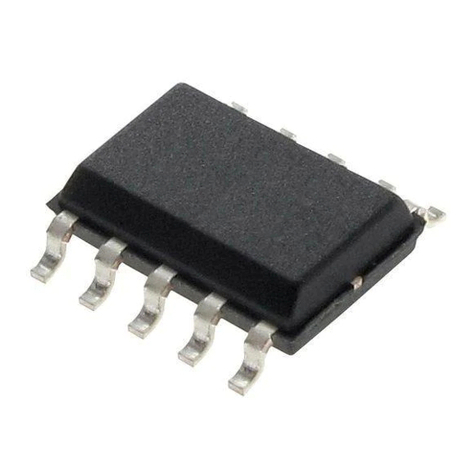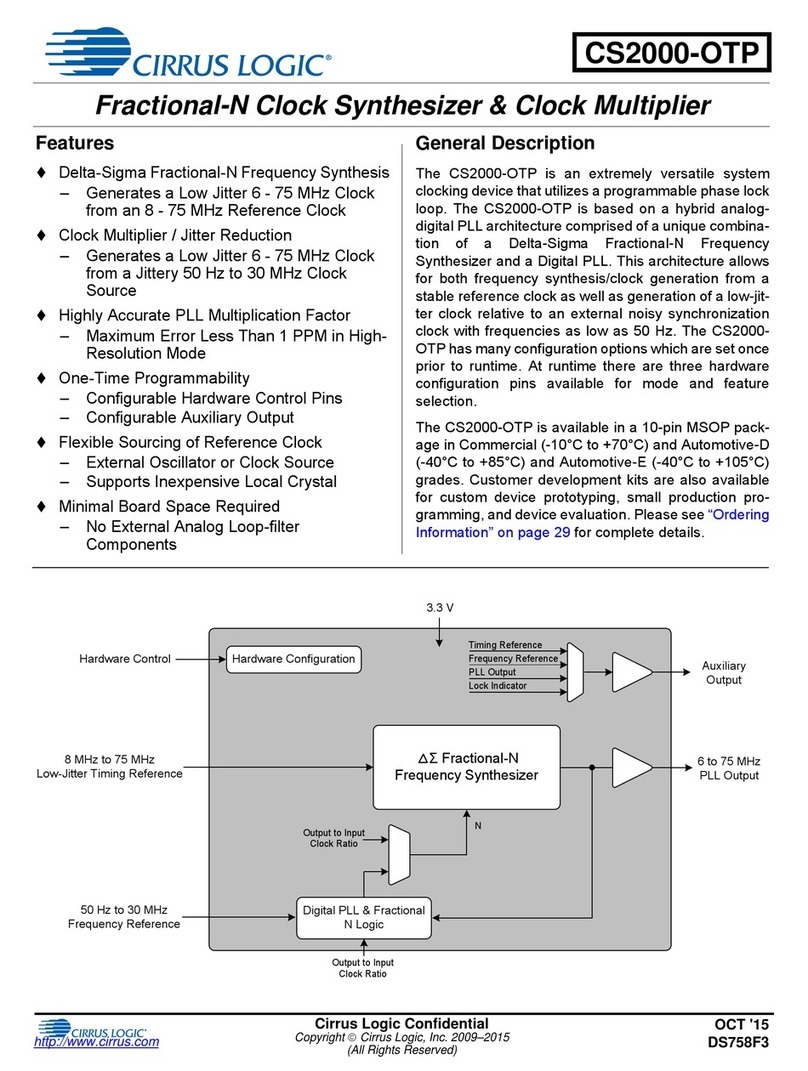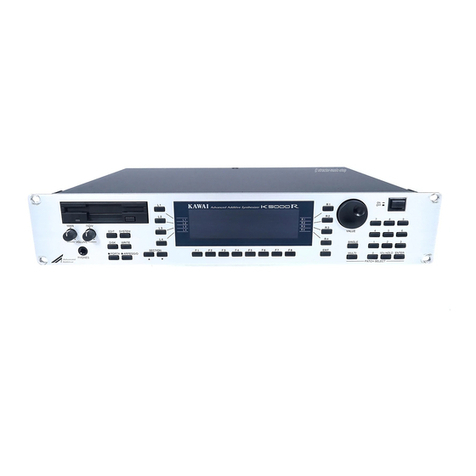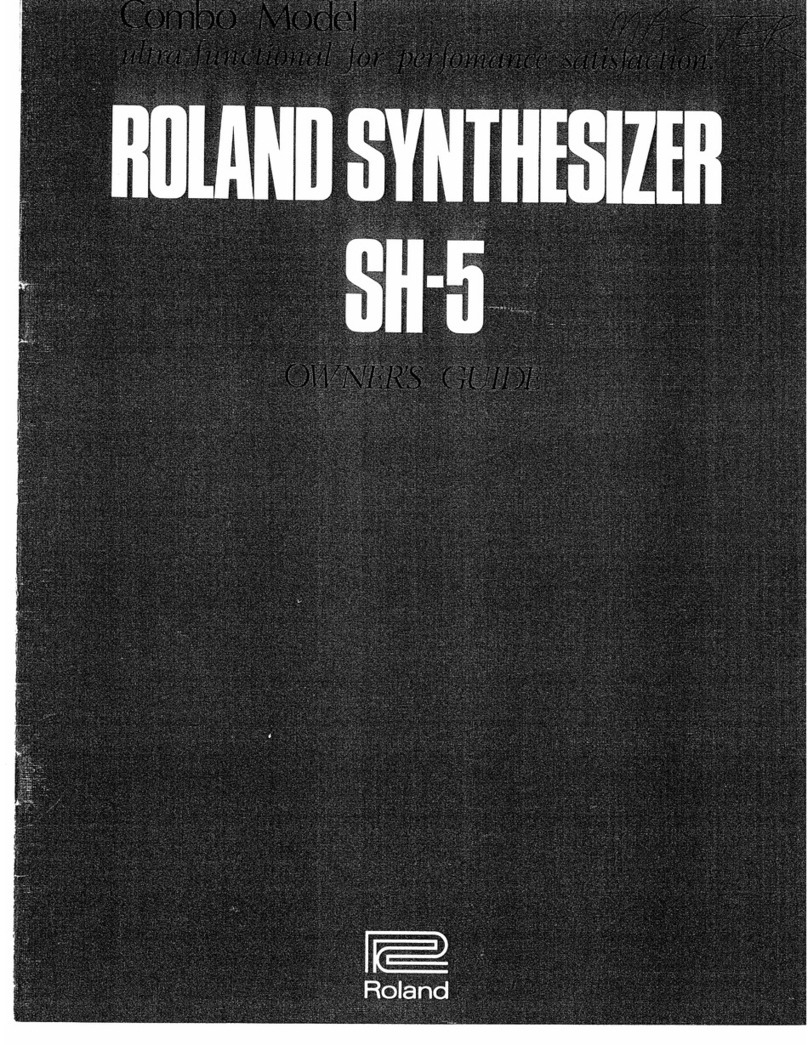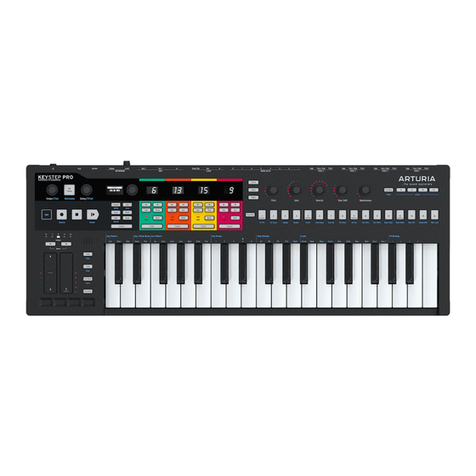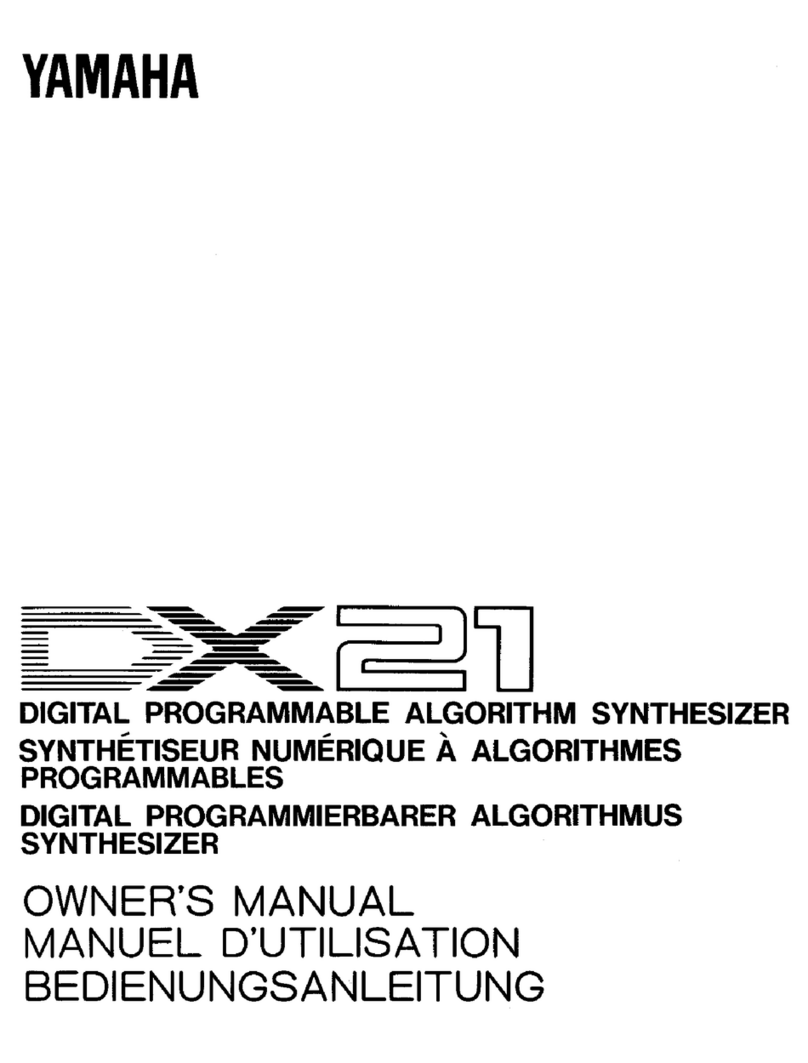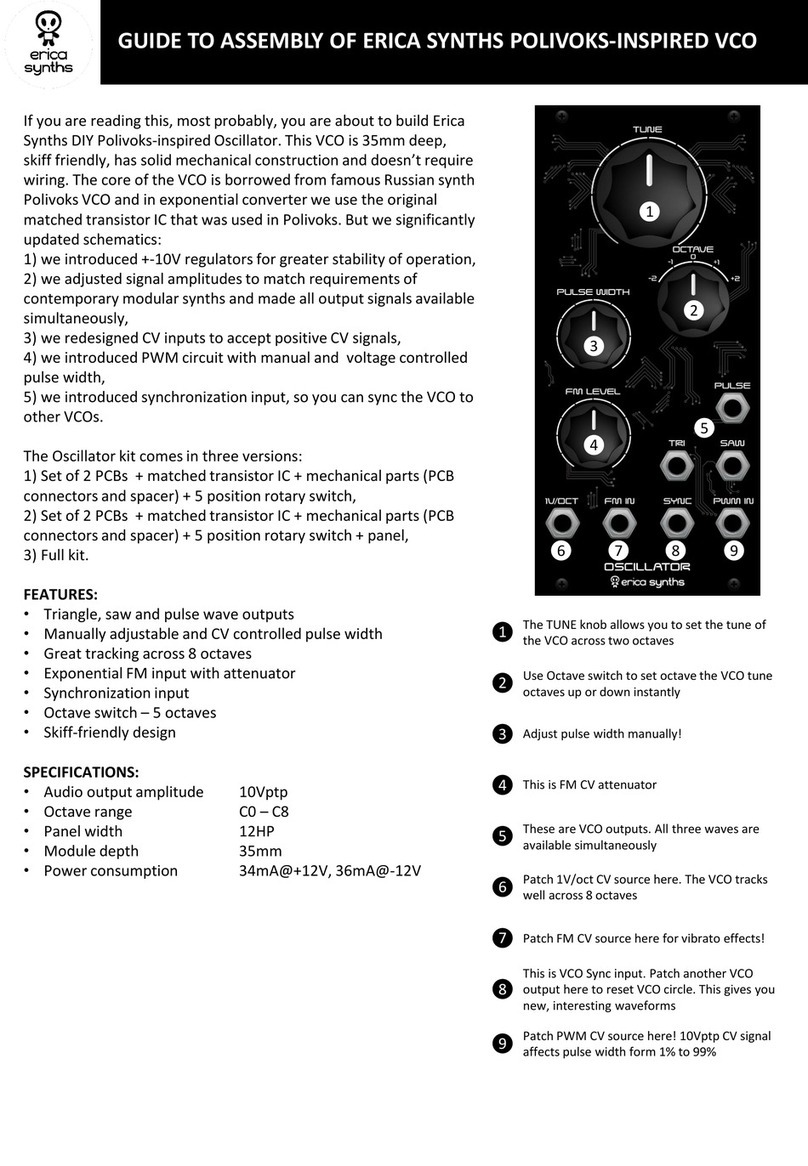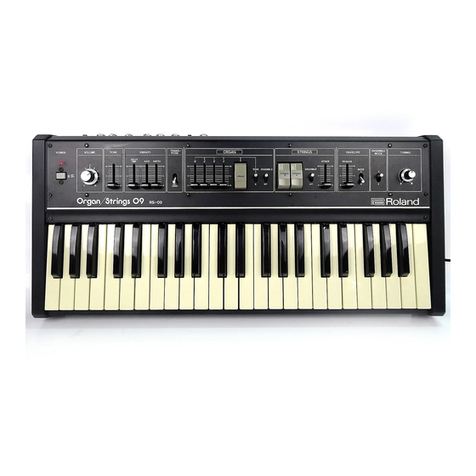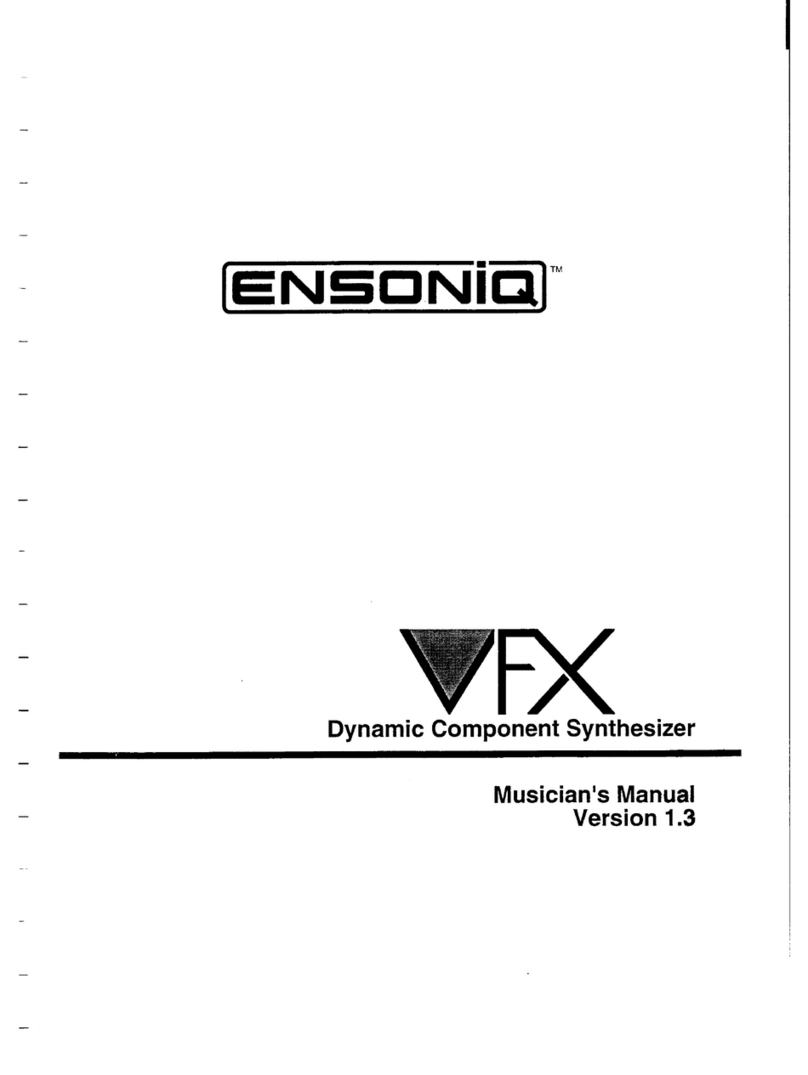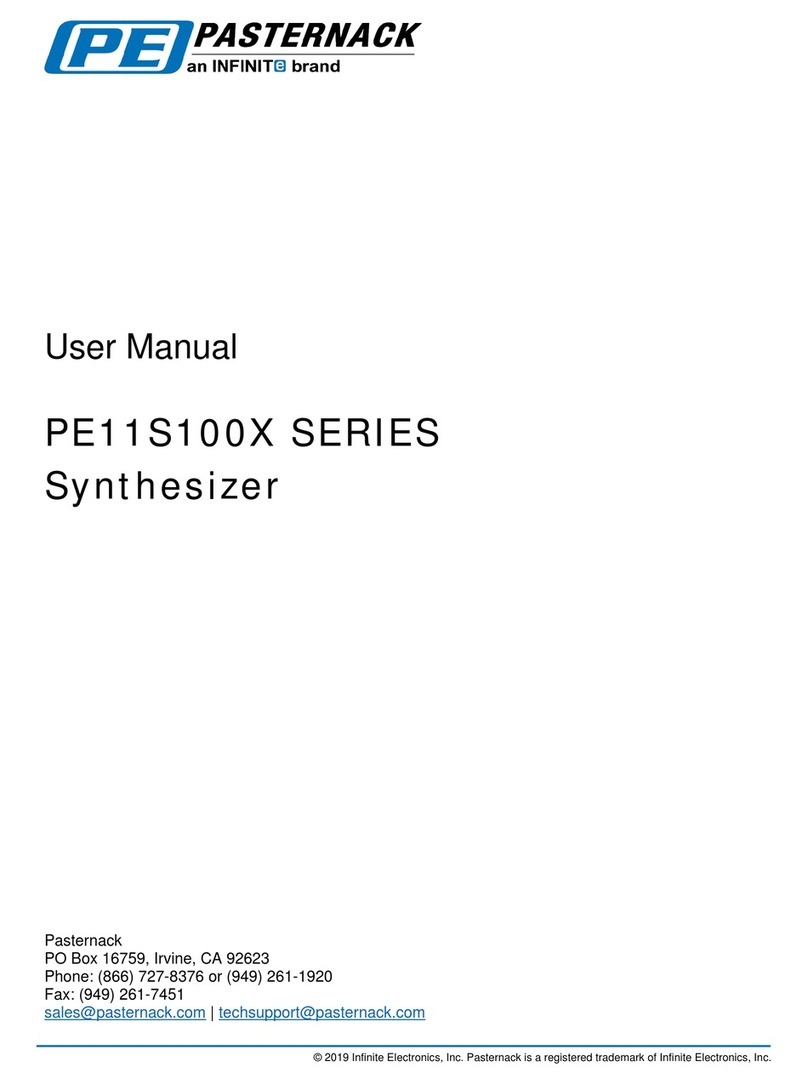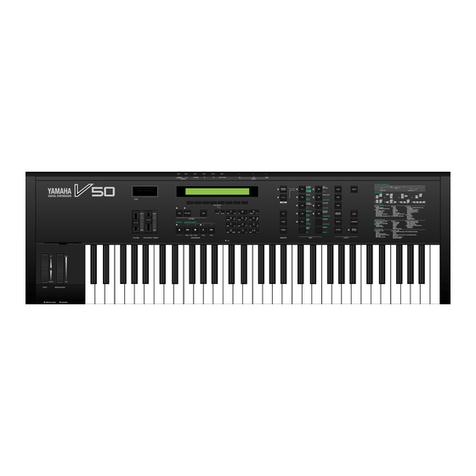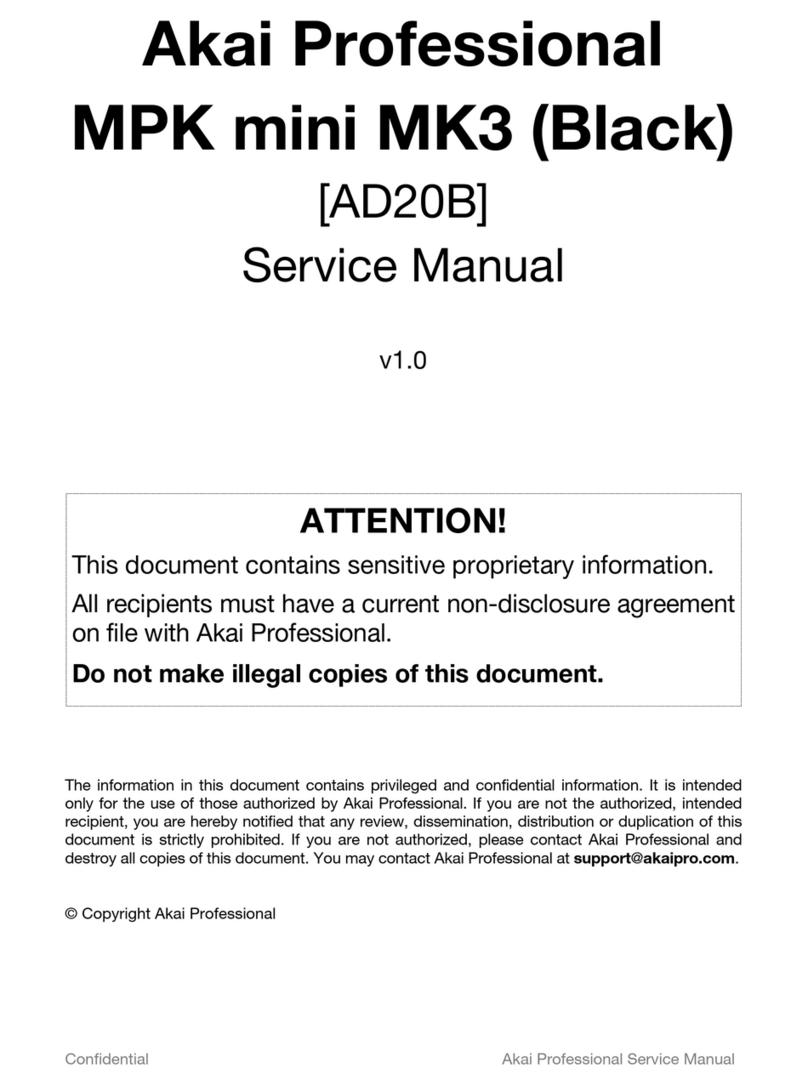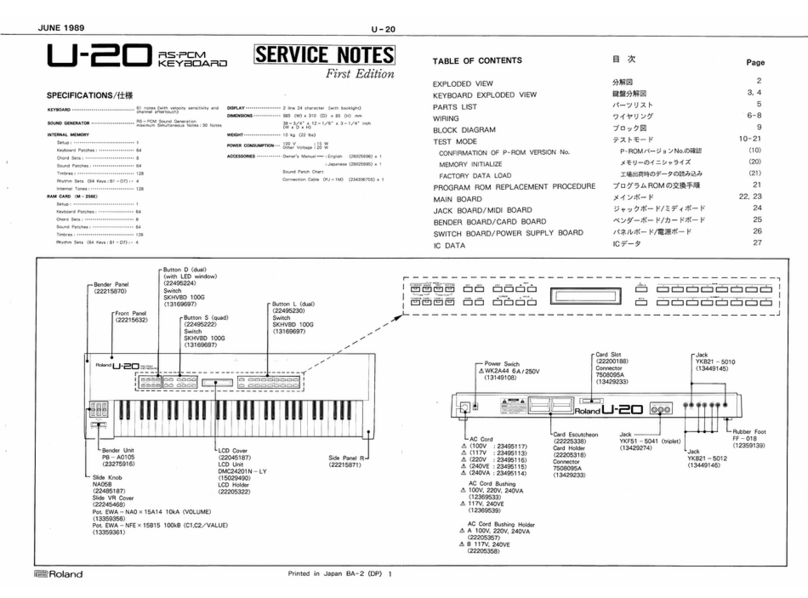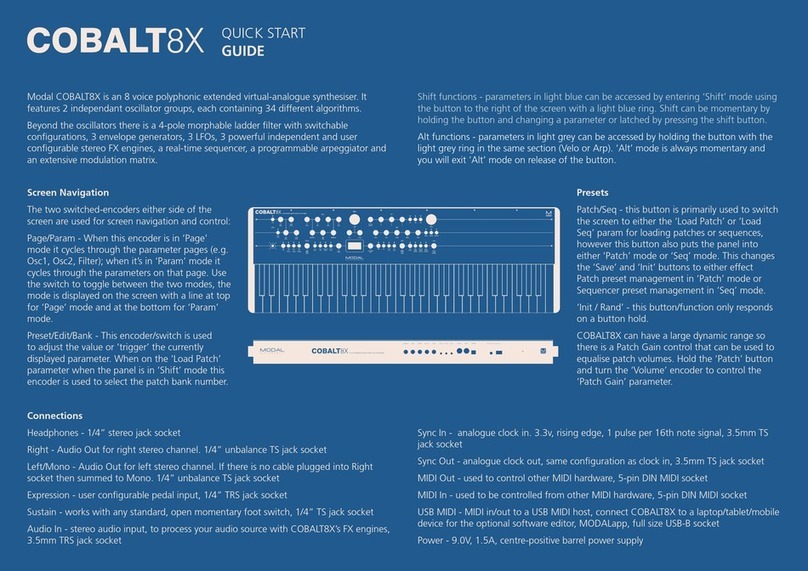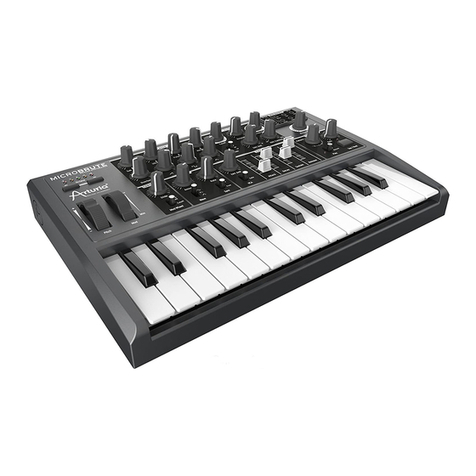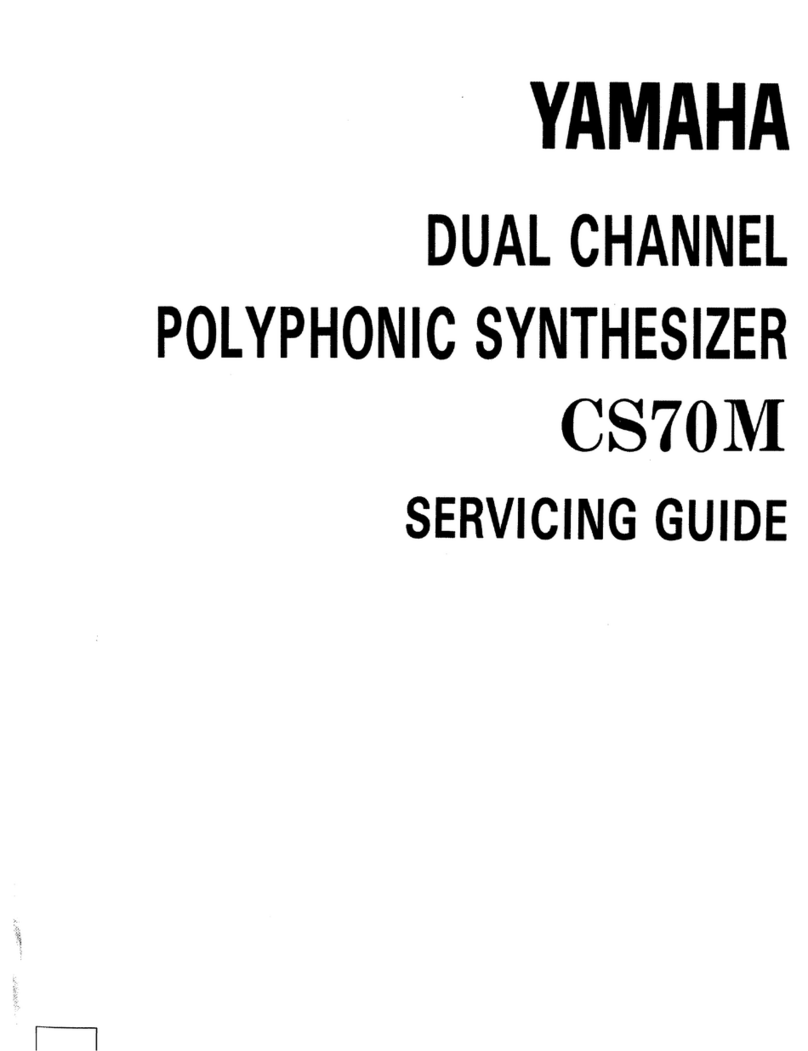Cirrus Logic CS2100-CP User manual

Cirrus Logic Confidential
Copyright Cirrus Logic, Inc. 2009–2015
(All Rights Reserved)
http://www.cirrus.com
Fractional-N Clock Multiplier
Features
Clock Multiplier / Jitter Reduction
– Generates a Low Jitter 6 - 75 MHz Clock
from a Jittery or Intermittent 50 Hz to 30
MHz Clock Source
Highly Accurate PLL Multiplication Factor
– Maximum Error Less Than 1 PPM in High-
Resolution Mode
I²C / SPI™ Control Port
Configurable Auxiliary Output
Flexible Sourcing of Reference Clock
– External Oscillator or Clock Source
– Supports Inexpensive Local Crystal
Minimal Board Space Required
– No External Analog Loop-filter
Components
General Description
The CS2100-CP is an extremely versatile system
clocking device that utilizes a programmable phase
lock loop. The CS2100-CP is based on a hybrid ana-
log-digital PLL architecture comprised of a unique
combination of a Delta-Sigma Fractional-N Frequency
Synthesizer and a Digital PLL. This architecture allows
for generation of a low-jitter clock relative to an exter-
nal noisy synchronization clock at frequencies as low
as 50 Hz. The CS2100-CP supports both I²C and SPI
for full software control.
The CS2100-CP is available in a 10-pin MSOP pack-
age in Commercial (-10°C to +70°C) and Automotive-
D (-40°C to +85°C) and Automotive-E (-40°C to
+105°C) grades. Customer development kits are also
available for device evaluation. Please see “Ordering
Information” on page 32 for complete details.
I²C / SPI Auxiliary
Output
6 to 75 MHz
PLL Output
3.3 V
I²C/SPI
Software Control
8 MHz to 75 MHz
Low-Jitter Timing
Reference
Fractional-N
Frequency Synthesizer
Digital PLL & Fractional
N Logic
Output to Input
Clock Ratio
N
Timing Reference
PLL Output
Lock Indicator
50 Hz to 30 MHz
Frequency
Reference
Frequency Reference
OCT '15
DS840F3
CS2100-CP

CS2100-CP
2DS840F3
TABLE OF CONTENTS
1. PIN DESCRIPTION ................................................................................................................................. 5
2. TYPICAL CONNECTION DIAGRAM ..................................................................................................... 6
3. CHARACTERISTICS AND SPECIFICATIONS ...................................................................................... 7
RECOMMENDED OPERATING CONDITIONS .................................................................................... 7
ABSOLUTE MAXIMUM RATINGS ........................................................................................................ 7
DC ELECTRICAL CHARACTERISTICS ................................................................................................ 7
AC ELECTRICAL CHARACTERISTICS ................................................................................................ 8
PLL PERFORMANCE PLOTS ............................................................................................................... 9
CONTROL PORT SWITCHING CHARACTERISTICS- I²C FORMAT ................................................. 10
CONTROL PORT SWITCHING CHARACTERISTICS - SPI FORMAT ............................................... 11
4. ARCHITECTURE OVERVIEW ............................................................................................................. 12
4.1 Delta-Sigma Fractional-N Frequency Synthesizer ......................................................................... 12
4.2 Hybrid Analog-Digital Phase Locked Loop ....................................................................................12
5. APPLICATIONS ................................................................................................................................... 14
5.1 Timing Reference Clock Input ........................................................................................................ 14
5.1.1 Internal Timing Reference Clock Divider ............................................................................... 14
5.1.2 Crystal Connections (XTI and XTO) ...................................................................................... 15
5.1.3 External Reference Clock (REF_CLK) .................................................................................. 15
5.2 Frequency Reference Clock Input, CLK_IN ................................................................................... 15
5.2.1 CLK_IN Skipping Mode ......................................................................................................... 15
5.2.2 Adjusting the Minimum Loop Bandwidth for CLK_IN ............................................................ 17
5.3 Output to Input Frequency Ratio Configuration ............................................................................. 18
5.3.1 User Defined Ratio (RUD) ..................................................................................................... 18
5.3.2 Ratio Modifier (R-Mod) .......................................................................................................... 19
5.3.3 Effective Ratio (REFF) .......................................................................................................... 20
5.3.4 Ratio Configuration Summary ............................................................................................... 20
5.4 PLL Clock Output ........................................................................................................................... 21
5.5 Auxiliary Output .............................................................................................................................. 21
5.6 Clock Output Stability Considerations ............................................................................................ 22
5.6.1 Output Switching ................................................................................................................... 22
5.6.2 PLL Unlock Conditions .......................................................................................................... 22
5.7 Required Power Up Sequencing .................................................................................................... 22
6. SPI / I²C CONTROL PORT ................................................................................................................... 22
6.1 SPI Control ..................................................................................................................................... 23
6.2 I²C Control ...................................................................................................................................... 23
6.3 Memory Address Pointer ............................................................................................................... 25
6.3.1 Map Auto Increment .............................................................................................................. 25
7. REGISTER QUICK REFERENCE ........................................................................................................ 25
8. REGISTER DESCRIPTIONS ................................................................................................................ 26
8.1 Device I.D. and Revision (Address 01h) ....................................................................................... 26
8.1.1 Device Identification (Device[4:0]) - Read Only ..................................................................... 26
8.1.2 Device Revision (Revision[2:0]) - Read Only ........................................................................ 26
8.2 Device Control (Address 02h) ........................................................................................................ 26
8.2.1 Unlock Indicator (Unlock) - Read Only .................................................................................. 26
8.2.2 Auxiliary Output Disable (AuxOutDis) ................................................................................... 26
8.2.3 PLL Clock Output Disable (ClkOutDis) .................................................................................. 27
8.3 Device Configuration 1 (Address 03h) ........................................................................................... 27
8.3.1 R-Mod Selection (RModSel[2:0]) ...........................................................................................27
8.3.2 Auxiliary Output Source Selection (AuxOutSrc[1:0]) ............................................................. 27
8.3.3 Enable Device Configuration Registers 1 (EnDevCfg1) ........................................................ 28
8.4 Global Configuration (Address 05h) ............................................................................................... 28
8.4.1 Device Configuration Freeze (Freeze) ................................................................................ 28

CS2100-CP
DS840F3 3
8.4.2 Enable Device Configuration Registers 2 (EnDevCfg2) ....................................................... 28
8.5 Ratio (Address 06h - 09h) .............................................................................................................. 28
8.6 Function Configuration 1 (Address 16h) ........................................................................................ 29
8.6.1 Clock Skip Enable (ClkSkipEn) ............................................................................................. 29
8.6.2 AUX PLL Lock Output Configuration (AuxLockCfg) .............................................................. 29
8.6.3 Reference Clock Input Divider (RefClkDiv[1:0]) .................................................................... 29
8.7 Function Configuration 2 (Address 17h) ........................................................................................ 30
8.7.1 Enable PLL Clock Output on Unlock (ClkOutUnl) ................................................................. 30
8.7.2 Low-Frequency Ratio Configuration (LFRatioCfg) ................................................................ 30
8.8 Function Configuration 3 (Address 1Eh) ........................................................................................ 30
8.8.1 Clock Input Bandwidth (ClkIn_BW[2:0]) ................................................................................ 30
9. CALCULATING THE USER DEFINED RATIO .................................................................................... 31
9.1 High Resolution 12.20 Format ....................................................................................................... 31
9.2 High Multiplication 20.12 Format ................................................................................................... 31
10. PACKAGE DIMENSIONS .................................................................................................................. 32
THERMAL CHARACTERISTICS ......................................................................................................... 32
11. ORDERING INFORMATION .............................................................................................................. 33
12. REFERENCES .................................................................................................................................... 33
13. REVISION HISTORY .......................................................................................................................... 34
LIST OF FIGURES
Figure 1. Typical Connection Diagram ........................................................................................................ 6
Figure 2. CLK_IN Sinusoidal Jitter Tolerance ............................................................................................. 9
Figure 3. CLK_IN Sinusoidal Jitter Transfer ................................................................................................ 9
Figure 4. CLK_IN Random Jitter Rejection and Tolerance .........................................................................9
Figure 5. Control Port Timing - I²C Format ................................................................................................ 10
Figure 6. Control Port Timing - SPI Format (Write Only) .......................................................................... 11
Figure 7. Delta-Sigma Fractional-N Frequency Synthesizer ..................................................................... 12
Figure 8. Hybrid Analog-Digital PLL .......................................................................................................... 13
Figure 9. Internal Timing Reference Clock Divider ................................................................................... 14
Figure 10. REF_CLK Frequency vs. a Fixed CLK_OUT ........................................................................... 14
Figure 11. External Component Requirements for Crystal Circuit ............................................................ 15
Figure 12. CLK_IN removed for > 223 SysClk cycles ................................................................................ 16
Figure 13. CLK_IN removed for < 223 SysClk cycles but > tCS .................................................................................. 16
Figure 14. CLK_IN removed for < tCS .................................................................................................................................. 17
Figure 15. Low bandwidth and new clock domain .................................................................................... 18
Figure 16. High bandwidth with CLK_IN domain re-use ........................................................................... 18
Figure 17. Ratio Feature Summary ........................................................................................................... 20
Figure 18. PLL Clock Output Options ....................................................................................................... 21
Figure 19. Auxiliary Output Selection ........................................................................................................ 21
Figure 20. Control Port Timing in SPI Mode ............................................................................................. 23
Figure 21. Control Port Timing, I²C Write .................................................................................................. 24
Figure 22. Control Port Timing, I²C Aborted Write + Read .......................................................................24
LIST OF TABLES
Table 1. Ratio Modifier .............................................................................................................................. 19
Table 2. Example 12.20 R-Values ............................................................................................................ 31
Table 3. Example 20.12 R-Values ............................................................................................................ 31

CS2100-CP
4DS840F3
1. PIN DESCRIPTION
Pin Name # Pin Description
VD 1 Digital Power (Input) - Positive power supply for the digital and analog sections.
GND 2 Ground (Input) - Ground reference.
CLK_OUT 3 PLL Clock Output (Output) - PLL clock output.
AUX_OUT 4Auxiliary Output (Output) - This pin outputs a buffered version of one of the input or output clocks,
or a status signal, depending on register configuration.
CLK_IN 5 Frequency Reference Clock Input (Input) - Clock input for the Digital PLL frequency reference.
XTO
XTI/REF_CLK
6
7
Crystal Connections (XTI/XTO) / Timing Reference Clock Input (REF_CLK) (Input/Output) -
XTI/XTO are I/O pins for an external crystal which may be used to generate the low-jitter PLL input
clock. REF_CLK is an input for an externally generated low-jitter reference clock.
AD0/CS 8Address Bit 0 (I²C) / Control Port Chip Select (SPI) (Input) - AD0 is a chip address pin in I²C
Mode. CS is the chip select signal in SPI Mode.
SCL/CCLK 9Control Port Clock (Input) - SCL/CCLK is the serial clock for the serial control port in I²C and SPI
mode.
SDA/CDIN 10 Serial Control Data (Input/Output) - SDA is the data I/O line in I²C Mode. CDIN is the input data
line for the control port interface in SPI Mode.
1
2
3
4
56
7
8
9
10
XTO
CLK_OUT
GND
VD
XTI/REF_CLK
AD0/CS
SCL/CCLK
SDA/CDIN
AUX_OUT
CLK_IN

CS2100-CP
DS840F3 5
2. TYPICAL CONNECTION DIAGRAM
2
1
GND
SCL/CCLK
SDA/CDIN
2 k
XTI/REF_CLK
Frequency Reference CLK_IN
XTO
CLK_OUT
AUX_OUT
0.1 µF
VD
+3.3 V
Notes:
1. Resistors
required for I2C
operation. 2 k
AD0/CS
Low-Jitter
Timing Reference
System MicroController
1 µF
Note1
1
or
2
REF_CLK
XTO
XTI
XTO
or
40 pF
x
40 pF
Crystal
To circuitry which requires
a low-jitter clock
N.C.
To other circuitry or
Microcontroller
Figure 1. Typical Connection Diagram
CS2100-CP

CS2100-CP
6DS840F3
3. CHARACTERISTICS AND SPECIFICATIONS
RECOMMENDED OPERATING CONDITIONS
GND = 0 V; all voltages with respect to ground. (Note 1)
Notes: 1. Device functionality is not guaranteed or implied outside of these limits. Operation outside of these limits
may adversely affect device reliability.
ABSOLUTE MAXIMUM RATINGS
GND = 0 V; all voltages with respect to ground.
WARNING:Operation at or beyond these limits may result in permanent damage to the device.
Notes: 2. The maximum over/under voltage is limited by the input current except on the power supply pin.
DC ELECTRICAL CHARACTERISTICS
Test Conditions (unless otherwise specified): VD = 3.1 V to 3.5 V; TA= -10°C to +70°C (Commercial Grade);
TA= -40°C to +85°C (Automotive-D Grade); TA= -40°C to +105°C (Automotive-E Grade).
Notes: 3. To calculate the additional current consumption due to loading (per output pin), multiply clock output
frequency by load capacitance and power supply voltage.
For example, fCLK_OUT (49.152 MHz) * CL (15 pF) * VD (3.3 V) = 2.4 mA of additional current due to
these loading conditions on CLK_OUT.
Parameters Symbol Min Typ Max Units
DC Power Supply VD 3.1 3.3 3.5 V
Ambient Operating Temperature (Power Applied)
Commercial Grade
Automotive-D Grade
Automotive-E Grade
TAC
TAD
TAE
-10
-40
-40
-
-
-
+70
+85
+105
°C
°C
°C
Parameters Symbol Min Max Units
DC Power Supply VD -0.3 6.0 V
Input Current IIN -±10mA
Digital Input Voltage (Note 2)V
IN -0.3 VD + 0.4 V
Ambient Operating Temperature (Power Applied) TA-55 125 °C
Storage Temperature Tstg -65 150 °C
Parameters Symbol Min Typ Max Units
Power Supply Current - Unloaded (Note 3)I
D-1218mA
Power Dissipation - Unloaded (Note 3)P
D-4060mW
Input Leakage Current IIN --±10µA
Input Capacitance IC-8-pF
High-Level Input Voltage VIH 70% - - VD
Low-Level Input Voltage VIL --30%VD
High-Level Output Voltage (IOH = -1.2 mA) VOH 80% - - VD
Low-Level Output Voltage (IOH = 1.2 mA) VOL --20%VD

CS2100-CP
DS840F3 7
AC ELECTRICAL CHARACTERISTICS
Test Conditions (unless otherwise specified): VD = 3.1 V to 3.5 V; TA= -10°C to +70°C (Commercial Grade);
TA= -40°C to +85°C (Automotive-D Grade); TA= -40°C to +105°C (Automotive-E Grade); CL=15pF.
Notes: 4. 1 UI (unit interval) corresponds to tSYS_CLK or 1/fSYS_CLK.
5. tCS represents the time from the removal of CLK_IN by which CLK_IN must be re-applied to ensure that
PLL_OUT continues while the PLL re-acquires lock. This timeout is based on the internal VCO frequen-
cy, with the minimum timeout occurring at the maximum VCO frequency. Lower VCO frequencies will
result in larger values of tCS.
6. Only valid in clock skipping mode; See “CLK_IN Skipping Mode” on page 14 for more information.
7. fCLK_OUT is ratio-limited when fCLK_IN is below 72 Hz.
8. fCLK_OUT = 24.576 MHz; Sample size = 10,000 points; AuxOutSrc[1:0] =11.
9. In accordance with AES-12id-2006 section 3.4.2. Measurements are Time Interval Error taken with 3rd
order 100 Hz to 40 kHz bandpass filter.
10. In accordance with AES-12id-2006 section 3.4.1. Measurements are Time Interval Error taken with 3rd
order 100 Hz Highpass filter.
11. 1 UI (unit interval) corresponds to tCLK_IN or 1/fCLK_IN.
12. The frequency accuracy of the PLL clock output is directly proportional to the frequency accuracy of the
reference clock.
Parameters Symbol Conditions Min Typ Max Units
Crystal Frequency
Fundamental Mode XTAL
fXTAL RefClkDiv[1:0] = 10
RefClkDiv[1:0] = 01
RefClkDiv[1:0] = 00
8
16
32
-
-
-
18.75
37.5
50
MHz
MHz
MHz
Reference Clock Input Frequency fREF_CLK RefClkDiv[1:0] = 10
RefClkDiv[1:0] = 01
RefClkDiv[1:0] = 00
8
16
32
-
-
-
18.75
37.5
75
MHz
MHz
MHz
Reference Clock Input Duty Cycle DREF_CLK 45 - 55 %
Internal System Clock Frequency fSYS_CLK 8 18.75 MHz
Clock Input Frequency fCLK_IN 50 Hz - 30 MHz
Clock Input Pulse Width (Note 4)pw
CLK_IN fCLK_IN < fSYS_CLK/96
fCLK_IN > fSYS_CLK/96
2
10
-
-
-
-
UI
ns
Clock Skipping Timeout tCS (Notes 5, 6)20--ms
Clock Skipping Input Frequency fCLK_SKIP (Note 6) 50 Hz - 80 kHz
PLL Clock Output Frequency fCLK_OUT (Note 7)6-75MHz
PLL Clock Output Duty Cycle tOD Measured at VD/2 45 50 55 %
Clock Output Rise Time tOR 20% to 80% of VD - 1.7 3.0 ns
Clock Output Fall Time tOF 80% to 20% of VD - 1.7 3.0 ns
Period Jitter tJIT (Note 8) - 70 - ps rms
Base Band Jitter (100 Hz to 40 kHz) (Notes 8, 9) - 50 - ps rms
Wide Band JItter (100 Hz Corner) (Notes 8, 10) - 175 - ps rms
PLL Lock Time - CLK_IN (Note 11)t
LC fCLK_IN < 200 kHz
fCLK_IN > 200 kHz
-
-
100
1
200
3
UI
ms
PLL Lock Time - REF_CLK tLR fREF_CLK = 8 to 75 MHz - 1 3 ms
Output Frequency Synthesis Resolution (Note 12)f
err High Resolution
High Multiplication
0
0
-
-
±0.5
±112
ppm
ppm

CS2100-CP
8DS840F3
PLL PERFORMANCE PLOTS
Test Conditions (unless otherwise specified): VD = 3.3 V; TA=25°C;C
L=15pF;f
CLK_OUT = 12.288 MHz;
fCLK_IN = 12.288 MHz; Sample size = 10,000 points; Base Band Jitter (100 Hz to 40 kHz); AuxOutSrc[1:0] =11.
110 100 1,000 10,000
0.1
1
10
100
1,000
10,000
Input Jitter Frequency (Hz)
Max Input Jitter Level (usec)
1 Hz Bandwidth
128 Hz Bandwidth
110 100 1000 10000
-60
-50
-40
-30
-20
-10
0
10
Input Jitter Frequency (Hz)
Jitter Transfer (dB)
1 Hz Bandwidth
128 Hz Bandwidth
Figure 2. CLK_IN Sinusoidal Jitter Tolerance Figure 3. CLK_IN Sinusoidal Jitter Transfer
Samples size = 2.5M points; Base Band Jitter (100Hz to 40kHz). Samples size = 2.5M points; Base Band Jitter (100Hz to 40kHz).
Figure 4. CLK_IN Random Jitter Rejection and Tolerance
0.01 0.1 110 100 1000
0.01
0.1
1
10
100
1000
Input Jitter Level (nsec)
Output Jitter Level (nsec)
1 Hz Bandwidth
128 Hz Bandwidth
Unlock
Unlock

CS2100-CP
DS840F3 9
CONTROL PORT SWITCHING CHARACTERISTICS- I²C FORMAT
Inputs: Logic 0 = GND; Logic 1 = VD; CL=20pF.
Notes: 13. Data must be held for sufficient time to bridge the transition time, tf, of SCL.
Parameter Symbol Min Max Unit
SCL Clock Frequency fscl - 100 kHz
Bus Free-Time Between Transmissions tbuf 4.7 - µs
Start Condition Hold Time (prior to first clock pulse) thdst 4.0 - µs
Clock Low Time tlow 4.7 - µs
Clock High Time thigh 4.0 - µs
Setup Time for Repeated Start Condition tsust 4.7 - µs
SDA Hold Time from SCL Falling (Note 13)t
hdd 0-µs
SDA Setup Time to SCL Rising tsud 250 - ns
Rise Time of SCL and SDA tr-1µs
Fall Time SCL and SDA tf- 300 ns
Setup Time for Stop Condition tsusp 4.7 - µs
Acknowledge Delay from SCL Falling tack 300 1000 ns
Delay from Supply Voltage Stable to Control Port Ready tdpor 100 - µs
tbuf thdst thdst
tlow tr
tf
thdd
thigh
tsud tsust
tsusp
Stop Start
Start Stop
Repeated
SDA
SCL
VD tdpor
Figure 5. Control Port Timing - I²C Format

CS2100-CP
10 DS840F3
CONTROL PORT SWITCHING CHARACTERISTICS - SPI FORMAT
Inputs: Logic 0 = GND; Logic 1 = VD; CL=20pF.
Notes: 14. tspi is only needed before first falling edge of CS after power is applied. tspi = 0 at all other times.
15. Data must be held for sufficient time to bridge the transition time of CCLK.
16. For fcclk < 1 MHz.
Parameter Symbol Min Max Unit
CCLK Clock Frequency fccllk -6MHz
CCLK Edge to CS Falling (Note 14)t
spi 500 - ns
CS High Time Between Transmissions tcsh 1.0 - µs
CS Falling to CCLK Edge tcss 20 - ns
CCLK Low Time tscl 66 - ns
CCLK High Time tsch 66 - ns
CDIN to CCLK Rising Setup Time tdsu 40 - ns
CCLK Rising to DATA Hold Time (Note 15)t
dh 15 - ns
Rise Time of CCLK and CDIN (Note 16)t
r2 - 100 ns
Fall Time of CCLK and CDIN (Note 16)t
f2 - 100 ns
Delay from Supply Voltage Stable to Control Port Ready tdpor 100 - µs
tr2 tf2
tdsu tdh
tsch
tscl
CS
CCLK
CDIN
tcss tcsh
tspi
tdpor
VD
Figure 6. Control Port Timing - SPI Format (Write Only)

CS2100-CP
DS840F3 11
4. ARCHITECTURE OVERVIEW
4.1 Delta-Sigma Fractional-N Frequency Synthesizer
The core of the CS2100 is a Delta-Sigma Fractional-N Frequency Synthesizer which has very high-resolu-
tion for Input/Output clock ratios, low phase noise, very wide range of output frequencies and the ability to
quickly tune to a new frequency. In very simplistic terms, the Fractional-N Frequency Synthesizer multiplies
the Timing Reference Clock by the value of N to generate the PLL output clock. The desired output to input
clock ratio is the value of N that is applied to the delta-sigma modulator (see Figure 7).
The analog PLL based frequency synthesizer uses a low-jitter timing reference clock as a time and phase
reference for the internal voltage controlled oscillator (VCO). The phase comparator compares the fraction-
al-N divided clock with the original timing reference and generates a control signal. The control signal is fil-
tered by the internal loop filter to generate the VCO’s control voltage which sets its output frequency. The
delta-sigma modulator modulates the loop integer divide ratio to get the desired fractional ratio between the
reference clock and the VCO output (thus the one’s density of the modulator sets the fractional value). This
allows the design to be optimized for very fast lock times for a wide range of output frequencies without the
need for external filter components. As with any Fractional-N Frequency Synthesizer the timing reference
clock should be stable and jitter-free.
Figure 7. Delta-Sigma Fractional-N Frequency Synthesizer
4.2 Hybrid Analog-Digital Phase Locked Loop
The addition of the Digital PLL and Fractional-N Logic (shown in Figure 8) to the Fractional-N Frequency
Synthesizer creates the Hybrid Analog-Digital Phase Locked Loop with many advantages over classical an-
alog PLL techniques. These advantages include the ability to operate over extremely wide frequency ranges
without the need to change external loop filter components while maintaining impressive jitter reduction per-
formance. In the Hybrid architecture, the Digital PLL calculates the ratio of the PLL output clock to the fre-
quency reference and compares that to the desired ratio. The digital logic generates a value of N which is
then applied to the Fractional-N frequency synthesizer to generate the desired PLL output frequency. Notice
that the frequency and phase of the timing reference signal do not affect the output of the PLL since the
digital control loop will correct for the PLL output. A major advantage of the Digital PLL is the ease with which
the loop filter bandwidth can be altered. The PLL bandwidth is automatically set to a wide-bandwidth mode
to quickly achieve lock and then reduced for optimal jitter rejection.
Fractional-N
Divider
Timing Reference
Clock PLL Output
Voltage Controlled
Oscillator
Internal
Loop Filter
Phase
Comparator
N
Delta-Sigma
Modulator

CS2100-CP
12 DS840F3
Figure 8. Hybrid Analog-Digital PLL
N
Digital Filter
Frequency
Comparator for
Frac-N Generation
Frequency Reference
Clock
Delta-Sigma Fractional-N Frequency Synthesizer
Digital PLL and Fractional-N Logic
Output to Input Ratio for Hybrid mode
Fractional-N
Divider
Timing Reference
Clock PLL Output
Voltage Controlled
Oscillator
Internal
Loop Filter
Phase
Comparator
Delta-Sigma
Modulator

CS2100-CP
DS840F3 13
5. APPLICATIONS
5.1 Timing Reference Clock Input
The low jitter timing reference clock (RefClk) can be provided by either an external reference clock or an
external crystal in conjunction with the internal oscillator. In order to maintain a stable and low-jitter PLL out-
put the timing reference clock must also be stable and low-jitter; the quality of the timing reference clock
directly affects the performance of the PLL and hence the quality of the PLL output.
5.1.1 Internal Timing Reference Clock Divider
The Internal Timing Reference Clock (SysClk) has a smaller maximum frequency than what is allowed on
the XTI/REF_CLK pin. The CS2100 supports the wider external frequency range by offering an internal
divider for RefClk. The RefClkDiv[1:0] bits should be set such that SysClk, the divided RefClk, then falls
within the valid range as indicated in “AC Electrical Characteristics” on page 7.
It should be noted that the maximum allowable input frequency of the XTI/REF_CLK pin is dependent
upon its configuration as either a crystal connection or external clock input. See the “AC Electrical Char-
acteristics” on page 7 for more details.
For the lowest possible output jitter, attention should be paid to the absolute frequency of the Timing Ref-
erence Clock relative to the PLL Output frequency (CLK_OUT). To minimize output jitter, the Timing Ref-
erence Clock frequency should be chosen such that fRefClk is at least +/-15 kHz from fCLK_OUT*N/32
where N is an integer. Figure 10 shows the effect of varying the RefClk frequency around fCLK_OUT*N/32.
It should be noted that there will be a jitter null at the zero point when N = 32 (not shown in Figure 10). An
example of how to determine the range of RefClk frequencies around 12 MHz to be used in order to
achieve the lowest jitter PLL output at a frequency of 12.288 MHz is as follows:
where:
and
Referenced Control Register Location
RefClkDiv[1:0] .......................“Reference Clock Input Divider (RefClkDiv[1:0])” on page 28
Figure 9. Internal Timing Reference Clock Divider
N
Internal Timing
Reference Clock
PLL Output
Fractional-N
Frequency
Synthesizer
Timing Reference
Clock Divider
1
2
4
XTI/REF_CLK
RefClkDiv[1:0]
8 MHz < SysClk < 18.75 MHz
8 MHz < RefClk <
Timing Reference Clock
50 MHz (XTI)
75 MHz (REF_CLK)
-80 -60 -40 -20 0 20 40 60 80
20
40
60
80
100
120
140
160
180
Normalized REF__CLK Frequency (kHz)
Typical Base Band Jitter (psec)
CLK__OUT Jit ter
-15 kHz +15 kHz
CLK__OUT
f *32/N
Figure 10. REF_CLK Frequency vs. a Fixed CLK_OUT
fLfRefClk fH
fLfCLK_OUT 31
32
------15kHz+=
12.288MHz 0.96875 15kHz+=
11.919MHz=
fHfCLK_OUT 32
32
------15kHz–=
12.288MHz 115kHz+=
12.273MHz=

CS2100-CP
14 DS840F3
5.1.2 Crystal Connections (XTI and XTO)
An external crystal may be used to generate RefClk. To accomplish this, a 20 pF fundamental mode par-
allel resonant crystal must be connected between the XTI and XTO pins as shown in Figure 11. As shown,
nothing other than the crystal and its load capacitors should be connected to XTI and XTO. Please refer
to the “AC Electrical Characteristics” on page 7 for the allowed crystal frequency range.
5.1.3 External Reference Clock (REF_CLK)
For operation with an externally generated REF_CLK signal, XTI/REF_CLK should be connected to the
reference clock source and XTO should be left unconnected or pulled low through a 47 kresistor to
GND.
5.2 Frequency Reference Clock Input, CLK_IN
The frequency reference clock input (CLK_IN) is used by the Digital PLL and Fractional-N Logic block to
dynamically generate a fractional-N value for the Frequency Synthesizer (see “Hybrid Analog-Digital PLL”
on page 12). The Digital PLL first compares the CLK_IN frequency to the PLL output. The Fractional-N logic
block then translates the desired ratio based off of CLK_IN to one based off of the internal timing reference
clock (SysClk). This allows the low-jitter timing reference clock to be used as the clock which the Frequency
Synthesizer multiplies while maintaining synchronicity with the frequency reference clock through the Digital
PLL. The allowable frequency range for CLK_IN is found in the “AC Electrical Characteristics” on page 7.
5.2.1 CLK_IN Skipping Mode
CLK_IN skipping mode allows the PLL to maintain lock even when the CLK_IN signal has missing pulses
for up to 20 ms (tCS) at a time (see “AC Electrical Characteristics” on page 7 for specifications). CLK_IN
skipping mode can only be used when the CLK_IN frequency is below 80 kHz and CLK_IN is reapplied
within 20 ms of being removed. The ClkSkipEn bit enables this function.
Regardless of the setting of the ClkSkipEn bit the PLL output will continue for 223 SysClk cycles (466 ms
to 1048 ms) after CLK_IN is removed (see Figure 12). This is true as long as CLK_IN does not glitch or
have an effective change in period as the clock source is removed, otherwise the PLL will interpret this as
a change in frequency causing clock skipping and the 223 SysClk cycle time-out to be bypassed and the
PLL to immediately unlock. If the prior conditions are met while CLK_IN is removed and 223 SysClk cycles
pass, the PLL will unlock and the PLL_OUT state will be determined by the ClkOutUnl bit; See “PLL Clock
Output” on page 20. If CLK_IN is re-applied after such time, the PLL will remain unlocked for the specified
time listed in the “AC Electrical Characteristics” on page 7 after which lock will be acquired and the PLL
XTI XTO
40 pF 40 pF
Figure 11. External Component Requirements for Crystal Circuit

CS2100-CP
DS840F3 15
output will resume.
If it is expected that CLK_IN will be removed and then reapplied within 223 SysClk cycles but later than
tCS, the ClkSkipEn bit should be disabled. If it is not disabled, the device will behave as shown in
Figure 13; note that the lower figure shows that the PLL output frequency may change and be incorrect
without an indication of an unlock condition.
Figure 12. CLK_IN removed for > 223 SysClk cycles
CLK_IN
PLL_OUT
UNLOCK
ClkSkipEn=0 or 1
ClkOutUnl=0
Lock Time
CLK_IN
PLL_OUT
UNLOCK
ClkSkipEn=0 or 1
ClkOutUnl=1
Lock Time
= invalid clocks
223 SysClk cycles 223 SysClk cycles
CLK_IN
PLL_OUT
UNLOCK
ClkSkipEn=0 or 1
ClkOutUnl=0
Lock Time
CLK_IN
PLL_OUT
UNLOCK
ClkSkipEn=0 or 1
ClkOutUnl=1
Lock Time
tCS tCS
= invalid clocks
CLK_IN
PLL_OUT
UNLOCK
ClkSkipEn= 1
ClkOutUnl= 0 or 1
Lock Time
tCS
= invalid clocks
223 SysClk cycles 223 SysClk cycles
223 SysClk cycles
Figure 13. CLK_IN removed for < 223 SysClk cycles but > tCS

CS2100-CP
16 DS840F3
If CLK_IN is removed and then re-applied within tCS, the ClkSkipEn bit determines whether PLL_OUT
continues while the PLL re-acquires lock (see Figure 14). When ClkSkipEn is disabled and CLK_IN is re-
moved the PLL output will continue until CLK_IN is re-applied at which point the PLL will go unlocked only
for the time it takes to acquire lock; the PLL_OUT state will be determined by the ClkOutUnl bit during this
time. When ClkSkipEn is enabled and CLK_IN is removed the PLL output clock will remain continuous
throughout the missing CLK_IN period including the time while the PLL re-acquires lock.
5.2.2 Adjusting the Minimum Loop Bandwidth for CLK_IN
The CS2100 allows the minimum loop bandwidth of the Digital PLL to be adjusted between 1 Hz and 128
Hz using the ClkIn_BW[2:0] bits. The minimum loop bandwidth of the Digital PLL directly affects the jitter
transfer function; specifically, jitter frequencies below the loop bandwidth corner are passed from the PLL
input directly to the PLL output without attenuation. In some applications it is desirable to have a very low
minimum loop bandwidth to reject very low jitter frequencies, commonly referred to as wander. In others
it may be preferable to remove only higher frequency jitter, allowing the input wander to pass through the
PLL without attenuation.
Typically, applications in which the PLL_OUT signal creates a new clock domain from which all other sys-
tem clocks and associated data are derived will benefit from the maximum jitter and wander rejection of
Referenced Control Register Location
ClkSkipEn..............................“Clock Skip Enable (ClkSkipEn)” on page 28
ClkOutUnl..............................“Enable PLL Clock Output on Unlock (ClkOutUnl)” on page 29
Figure 14. CLK_IN removed for < tCS
CLK_IN
PLL_OUT
UNLOCK
ClkSkipEn=1
ClkOutUnl=0 or 1
CLK_IN
PLL_OUT
UNLOCK
ClkSkipEn=0
ClkOutUnl=1
Lock Time
CLK_IN
PLL_OUT
UNLOCK
ClkSkipEn=0
ClkOutUnl=0
Lock Time
tCS tCS
tCS
= invalid clocks

CS2100-CP
DS840F3 17
the lowest PLL bandwidth setting. See Figure 15.
Systems in which some clocks and data are derived from the PLL_OUT signal while other clocks and data
are derived from the CLK_IN signal will often require phase alignment of all the clocks and data in the
system. See Figure 16. If there is substantial wander on the CLK_IN signal in these applications, it may
be necessary to increase the minimum loop bandwidth allowing this wander to pass through to the
CLK_OUT signal in order to maintain phase alignment. For these applications, it is advised to experiment
with the loop bandwidth settings and choose the lowest bandwidth setting that does not produce system
timing errors due to wandering between the clocks and data synchronous to the CLK_IN domain and
those synchronous to the PLL_OUT domain.
It should be noted that manual adjustment of the minimum loop bandwidth is not necessary to acquire
lock; this adjustment is made automatically by the Digital PLL. While acquiring lock, the digital loop band-
width is automatically set to a large value. Once lock is achieved, the digital loop bandwidth will settle to
the minimum value selected by the ClkIn_BW[2:0] bits.
5.3 Output to Input Frequency Ratio Configuration
5.3.1 User Defined Ratio (RUD)
The User Defined Ratio, RUD, is a 32-bit un-signed fixed-point number, stored in the Ratio register set,
which determines the basis for the desired input to output clock ratio. The 32-bit RUD can be expressed
Referenced Control Register Location
ClkIn_BW[2:0] ....................... “Clock Input Bandwidth (ClkIn_BW[2:0])” on page 29
Figure 15. Low bandwidth and new clock domain
LRCK
SCLK
SDATA
MCLK
MCLK
Wander > 1 Hz
Wander and Jitter > 1 Hz Rejected
D0 D1
LRCK
SCLK
SDATA
Subclocks generated
from new clock domain.
or
PLL
BW = 1 Hz
CLK_IN PLL_OUT
D0 D1
Jitter
Figure 16. High bandwidth with CLK_IN domain re-use
D0 D1
LRCK
SCLK
SDATA
MCLK
MCLK
Wander < 128 Hz
Jitter > 128 Hz Rejected
Wander < 128 Hz Passed to Output
LRCK
SCLK
SDATA
or
PLL
BW = 128 Hz
CLK_IN PLL_OUT
Subclocks and data re-used
from previous clock domain.
Jitter
D0 D1

CS2100-CP
18 DS840F3
in either a high resolution (12.20) or high multiplication (20.12) format selectable by the LFRatioCfg bit,
with 20.12 being the default.
The RUD for high resolution (12.20) format is encoded with 12 MSBs representing the integer binary por-
tion with the remaining 20 LSBs representing the fractional binary portion. The maximum multiplication
factor is approximately 4096 with a resolution of 0.954 PPM in this configuration. See “Calculating the
User Defined Ratio” on page 30 for more information.
The RUD for high multiplication (20.12) format is encoded with 20 MSBs representing the integer binary
portion with the remaining 12 LSBs representing the fractional binary portion. In this configuration, the
maximum multiplication factor is approximately 1,048,575 with a resolution of 244 PPM. It is recommend-
ed that the 12.20 High-Resolution format be utilized whenever the desired ratio is less than 4096 since
the output frequency accuracy of the PLL is directly proportional to the accuracy of the timing reference
clock and the resolution of the RUD.
The status of internal dividers, such as the internal timing reference clock divider, are automatically taken
into account. Therefore RUD is simply the desired ratio of the output to input clock frequencies.
5.3.2 Ratio Modifier (R-Mod)
The Ratio Modifier is used to internally multiply/divide the RUD (the Ratio stored in the register space re-
mains unchanged). The available options for RMOD are summarized in Table 1 on page 18.
The R-Mod value selected by RModSel[2:0] is always used in the calculation for the Effective Ratio
(REFF), see “Effective Ratio (REFF)” on page 19. If R-Mod is not desired, RModSel[2:0] should be left at
its default value of ‘000’, which corresponds to an R-Mod value of 1, thereby effectively disabling the ratio
modifier.
Table 1. Ratio Modifier
Referenced Control Register Location
Ratio......................................“Ratio (Address 06h - 09h)” on page 27
LFRatioCfg ............................ “Low-Frequency Ratio Configuration (LFRatioCfg)” on page 29
RModSel[2:0] Ratio Modifier
000 1
001 2
010 4
011 8
100 0.5
101 0.25
110 0.125
111 0.0625
Referenced Control Register Location
Ratio......................................“Ratio (Address 06h - 09h)” on page 27
RModSel[2:0] ........................“R-Mod Selection (RModSel[2:0])” section on page 26

CS2100-CP
DS840F3 19
5.3.3 Effective Ratio (REFF)
The Effective Ratio (REFF) is an internal calculation comprised of RUD and the appropriate modifiers, as
previously described. REFF is calculated as follows:
REFF = RUD RMOD
To simplify operation the device handles some of the ratio calculation functions automatically (such as
when the internal timing reference clock divider is set). For this reason, the Effective Ratio does not need
to be altered to account for internal dividers.
Ratio modifiers which would produce an overflow or truncation of REFF should not be used; For example
if RUD is 1024 an RMOD of 8 would produce an REFF value of 8192 which exceeds the 4096 limit of the
12.20 format. In all cases, the maximum and minimum allowable values for REFF are dictated by the fre-
quency limits for both the input and output clocks as shown in the “AC Electrical Characteristics” on
page 7.
5.3.4 Ratio Configuration Summary
The RUD is the user defined ratio stored in the register space. The resolution for the RUD is selectable by
setting LFRatioCfg. R-Mod is applied if selected. The user defined ratio, and ratio modifier make up the
effective ratio REFF, the final calculation used to determine the output to input clock ratio. The effective
ratio is then corrected for the internal dividers. The conceptual diagram in Figure 17 summarizes the fea-
tures involved in the calculation of the ratio values used to generate the fractional-N value which controls
the Frequency Synthesizer.
Figure 17. Ratio Feature Summary
Referenced Control Register Location
Ratio......................................“Ratio (Address 06h - 09h)” on page 27
LFRatioCfg ............................ “Low-Frequency Ratio Configuration (LFRatioCfg)” on page 29
RModSel[2:0] ........................“R-Mod Selection (RModSel[2:0])” section on page 26
RefClkDiv[1:0] .......................“Reference Clock Input Divider (RefClkDiv[1:0])” on page 28
Effective Ratio REFF
Ratio Format
Frequency Reference Clock
(CLK_IN)
SysClk PLL Output
Frequency
Synthesizer
Digital PLL &
Fractional N Logic
N
Ratio 12.20
20.12
LFRatioCfg
RModSel[2:0]
Ratio
Modifier R Correction
RefClkDiv[1:0]
Timing Reference Clock
(XTI/REF_CLK) Divide
RefClkDiv[1:0]
User Defined Ratio RUD

CS2100-CP
20 DS840F3
5.4 PLL Clock Output
The PLL clock output pin (CLK_OUT) provides a buffered version of the output of the frequency synthesizer.
The driver can be set to high-impedance with the ClkOutDis bit.
The output from the PLL automatically drives a static low condition while the PLL is un-locked (when the
clock may be unreliable). This feature can be disabled by setting the ClkOutUnl bit, however the state
CLK_OUT may then be unreliable during an unlock condition.
Figure 18. PLL Clock Output Options
5.5 Auxiliary Output
The auxiliary output pin (AUX_OUT) can be mapped, as shown in Figure 19, to one of four signals: refer-
ence clock (RefClk), input clock (CLK_IN), additional PLL clock output (CLK_OUT), or a PLL lock indicator
(Lock). The mux is controlled via the AuxOutSrc[1:0] bits. If AUX_OUT is set to Lock, the AuxLockCfg bit is
then used to control the output driver type and polarity of the LOCK signal (see section 8.6.2 on page 28).
In order to indicate an unlock condition, REF_CLK must be present. If AUX_OUT is set to CLK_OUT the
phase of the PLL Clock Output signal on AUX_OUT may differ from the CLK_OUT pin. The driver for the
pin can be set to high-impedance using the AuxOutDis bit.
Figure 19. Auxiliary Output Selection
Referenced Control Register Location
ClkOutUnl..............................“Enable PLL Clock Output on Unlock (ClkOutUnl)” on page 29
ClkOutDis .............................. “PLL Clock Output Disable (ClkOutDis)” on page 26
Referenced Control Register Location
AuxOutSrc[1:0]......................“Auxiliary Output Source Selection (AuxOutSrc[1:0])” on page 26
AuxOutDis ............................. “Auxiliary Output Disable (AuxOutDis)” on page 25
AuxLockCfg...........................“AUX PLL Lock Output Configuration (AuxLockCfg)” section on page 28
PLL Locked/Unlocked
PLL Output
2:1 Mux
ClkOutDis
2:1 Mux
ClkOutUnl
0
PLL Clock Output Pin
(CLK_OUT)
0
1
0
1
PLL Clock Output
PLLClkOut
Frequency Reference Clock
(CLK_IN)
PLL Lock/Unlock Indication
(Lock)
Timing Reference Clock
(RefClk)
PLL Clock Output
(PLLClkOut)
4:1 Mux Auxiliary Output Pin
(AUX_OUT)
AuxOutDis
AuxOutSrc[1:0]
AuxLockCfg
This manual suits for next models
2
Table of contents
Other Cirrus Logic Synthesizer manuals
